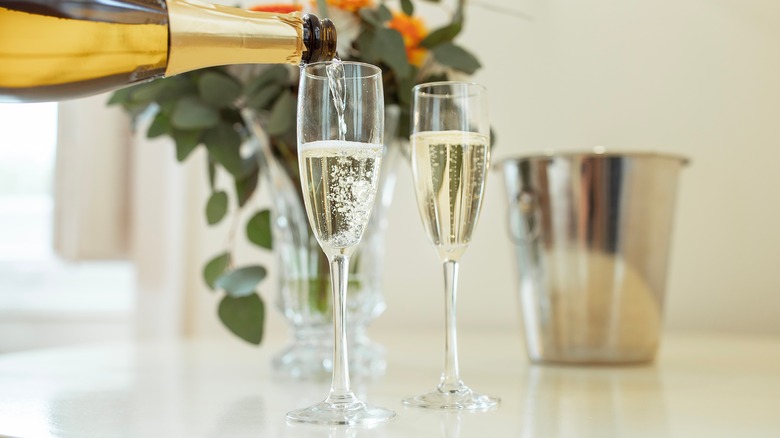How Long Does Champagne Usually Last After Opening?
When you've finally found the perfect reason to open a bottle of champagne, you might wonder how long you have to enjoy it at its bubbliest or what happens if you and your guests don't finish the bottle. Luckily, you won't have to go pouring it down the drain right away. Whether you're toasting with champagne on its own or want to repurpose leftover champagne for mimosas at brunch, the fizzy stuff can last up to five days when stored in the refrigerator if you have a proper champagne stopper on hand.
If you're in a bind and can only cover up the opening of the champagne bottle instead of using a champagne stopper, you'll have about two to three days to enjoy it after storing it in the fridge. Just know that the longer you wait in that time frame, the more the champagne loses its verve and quality. And remember to keep your champagne in a bucket of ice and cold water while serving, as the freshness clock starts ticking as soon as the bottle is opened.
The science of champagne storage
You know that unmistakable fizz you hear after opening a bottle of champagne? That's the carbon dioxide escaping from the bottle after the seal has been broken when you uncork the bottle. You want as little of that CO2 to escape as possible. A champagne stopper will come closest to mimicking sealing up the champagne again, and storing it in a very cold environment like your fridge slows down the process of CO2 release.
Without a champagne stopper on hand, you'll have to turn to some other common household kitchen items. Covering the opening tightly with plastic wrap or aluminum foil will work in a pinch. Twist a rubber band around the neck of the bottle to make sure the wrap or foil is sealed tight across the bottle opening.
If you're pushing that two- to three-day freshness window and want to check to ensure your champagne hasn't gone bad, simply rely on your senses. Take a whiff of the champagne — it should have the drink's fruity or floral signature aroma. If you smell anything off-putting or sour, it's likely gone bad. If you're still unsure, you can take a small sip. Again, if there's a sour taste or you can tell it's gone entirely flat, you're out of luck, and unfortunately, that bottle of champagne's got to go.
Steer clear of common champagne storage mistakes
Just as there are many mistakes to be made when drinking champagne, you can also make mistakes when storing it. Most obviously, one significant error is putting the bottle back in the fridge without covering the top at all. And don't believe any tales about storing your champagne with a metal spoon inserted into the top to help retain fizziness. It's been disproven and doesn't actually make a difference in extending the life of your opened champagne or wine.
You might assume that if your opened champagne needs a cold environment to stay fresh, it should go in the freezer. However, you should try to avoid this if at all possible. The freezer will only destroy any carbon dioxide in the champagne and make the drink too cold for any of its more nuanced flavors to come out, leaving you with flat, freezing-cold champagne that's no longer enjoyable. Although it's always best to fully enjoy your champagne while fresh, if you properly store your opened bottle in the refrigerator with a champagne stopper or secure wrapping, you should be able to keep the bubbly flowing up to a few days later.


